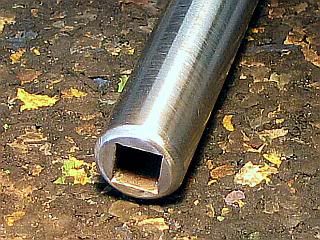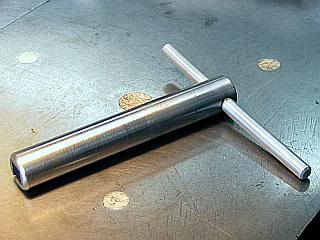You are using an out of date browser. It may not display this or other websites correctly.
You should upgrade or use an alternative browser.
You should upgrade or use an alternative browser.
Square holes
- Thread starter Jtrain
- Start date

Help Support Home Model Engine Machinist Forum:
This site may earn a commission from merchant affiliate
links, including eBay, Amazon, and others.
Twmaster
Well-Known Member
- Joined
- Oct 24, 2009
- Messages
- 917
- Reaction score
- 3
Yes, you'd make a round hole slightly smaller and broach. Or is you are careful and skilled file!
Examples here: http://www.steelmans.com/square_broaches.htm
Examples here: http://www.steelmans.com/square_broaches.htm
- Joined
- Feb 17, 2008
- Messages
- 2,326
- Reaction score
- 440
Depending on the application, you may be able to mill a 1/4 inch deep slot in the edge of the plate with a 1/4 end mill and then weld/screw/silver braze a second piece over the slot to leave a 1/4 inch square hole. I have done this several times.
Gail in NM
Gail in NM
Hi Guys
This is another novel way of doing it, I think it works on some kind of
a cam, although the hole may not be perfectly square, still a neat idea.
[ame]http://www.youtube.com/watch?v=9qEhyQfbImY&feature=related[/ame]
This is another novel way of doing it, I think it works on some kind of
a cam, although the hole may not be perfectly square, still a neat idea.
[ame]http://www.youtube.com/watch?v=9qEhyQfbImY&feature=related[/ame]
tel
Well-Known Member
- Joined
- Feb 8, 2008
- Messages
- 3,293
- Reaction score
- 44
For a square hole that small and long, Gail's method is what I usually use, even on things that have to be round on the outside. For thinner workpieces you can often get away with punching a 1/4 tool bit though a marginally undersized hole.
I have no idea how that worked!! ???Square Hole Drilling
I do notice he started with a square hole and ended up with a bigger one.
Take a look at these they work http://www.slatertools.com/
You can use a square-hole sleeve, for example http://www.reidsupply.com/Detail.aspx?itm=SHSG-P25 , inserted with silver solder or Loctite 609.
- Joined
- Feb 17, 2008
- Messages
- 2,326
- Reaction score
- 440
As Mainer mentioned, you can buy square hole sleeves. Sleeves are one of the few ways you put a blind square hole in a part. It only takes a short time to make a sleeve up using the method I outlined in post #3. Start with a round rod and mill the slot in in and a flat for the cover piece. Silver solder the cover plate on and then turn the result round to make a sleeve that you can cut off. Insert the sleeve in a hole that is drilled or bored to fit the sleeve (or turn the sleeve to fit a hole). Press fit or Loctite in place with a high strength Loctite.
Here is a special wrench I made this way to to fit a magnetic chuck. I needed one longer than I could purchase to clear a fixture on the chuck. The hole is 5/16 square. The shank is 5/8 diameter.
Gail in NM


Here is a special wrench I made this way to to fit a magnetic chuck. I needed one longer than I could purchase to clear a fixture on the chuck. The hole is 5/16 square. The shank is 5/8 diameter.
Gail in NM


At work we often have to make precise, shallow pockets. The corners have to accomodate square or rectangular pieces of glass, so we need to clear the corners. We make corner reliefs with a drill or mill, and then cut the pocket. I've made a little pic to describe what I mean:


Dan Rowe
Well-Known Member
- Joined
- Feb 12, 2010
- Messages
- 594
- Reaction score
- 18
All the methods mentioned will work fine. Here is another.
On one class of ship I worked all the spare flexible couplings were not bored to save on the number of spares required. Well of course we did not have a keyway broach to make things simple. I tried several methods and used the lathe as a shaper but none of the methods worked quicker or better for me than drilling a hole in the unbored coupling slightly oversize of the key. A standard square tool bit was hammered into the hole using a copper hammer. This will upset a slight bur in the hole. A hand drill is set up with the drill used for the hole and the bur removed. Hit the bit with the hammer remove the bur repete. This works fairly fast and gives reasonable results. (Much better than the lathe shaper method)
I have used this method to make a boring bar held between centers to machine a cylinder bolted to the lathe carrage.
Dan
On one class of ship I worked all the spare flexible couplings were not bored to save on the number of spares required. Well of course we did not have a keyway broach to make things simple. I tried several methods and used the lathe as a shaper but none of the methods worked quicker or better for me than drilling a hole in the unbored coupling slightly oversize of the key. A standard square tool bit was hammered into the hole using a copper hammer. This will upset a slight bur in the hole. A hand drill is set up with the drill used for the hole and the bur removed. Hit the bit with the hammer remove the bur repete. This works fairly fast and gives reasonable results. (Much better than the lathe shaper method)
I have used this method to make a boring bar held between centers to machine a cylinder bolted to the lathe carrage.
Dan
deadin said:I do notice he started with a square hole and ended up with a bigger one.
It kind of looks that way in the video, but these start with a round hole. The piece he's putting on the
end of the workpiece in the beginning of the vid is a guide die.
I've seen one of these in a shop where I worked part time. It was a factory made unit, but I don't
remember the brand. The dies tell the size of hole to drill for making a given size straight sided hole.
Then the die guides the cutter and you have a really nice square or hex. I seem to remember it being
able to make other shapes too, but it was some time back. It made a bit of racket, too!
I think Gail's way of doing it sounds pretty straight forward. Much cheaper than a set of broaches,
that's for sure. Dan's method sounds good, too, but I would probably get the square off center. That's
just me!
Dean
The square hole drills are old tech. They have a triangular shaped cutter that is free to float but rotates with the input shaft. The is a guide "die" in the shape of a square that guides the cutting tool to form the square hole. A community college teacher took his class on a tour of his shop and he had one in use for something, this was 15 years ago.
Today, the rotary broach is common in turning centers.
At home I would likely try the brazed or soldered part if it offered the required strength. I have milled odd shapes like this for drive components with CNC. As shown above you just add reliefs where required for clearance.
Greg
Today, the rotary broach is common in turning centers.
At home I would likely try the brazed or soldered part if it offered the required strength. I have milled odd shapes like this for drive components with CNC. As shown above you just add reliefs where required for clearance.
Greg
Hi Guys,
For me the easiest way to make a square hole is to use the square sleeve method but make the sleeve yourself in two pieces.
To make a two piece sleeve, start with a piece of round stock the next size up from the across corners size of square you want. Put this in the lathe and drill a hole the across flats size of the wanted square. Drill to a depth of at least twice the length of the Sq. hole you want. Mount the stock in your mill vice with the drilled hole section poking out the side. Now mill away lengthways till you just leave a witness line of the drilled hole. Cut the "angled C" section into two pieces and file across the sharp corners till you get to exactly half diameter of the original stock. Finally glue or silver solder these two "angled C" pieces into whatever you want the square hole to be in.
I know pictures would help in describing this technique, but I'm sure that anyone of you who could make this will be able to work out what I mean.
I saw this technique at Ally-Pally (the Brits reading this will know what this is) a few years ago on the SMEE stand and it does work.
Ned
For me the easiest way to make a square hole is to use the square sleeve method but make the sleeve yourself in two pieces.
To make a two piece sleeve, start with a piece of round stock the next size up from the across corners size of square you want. Put this in the lathe and drill a hole the across flats size of the wanted square. Drill to a depth of at least twice the length of the Sq. hole you want. Mount the stock in your mill vice with the drilled hole section poking out the side. Now mill away lengthways till you just leave a witness line of the drilled hole. Cut the "angled C" section into two pieces and file across the sharp corners till you get to exactly half diameter of the original stock. Finally glue or silver solder these two "angled C" pieces into whatever you want the square hole to be in.
I know pictures would help in describing this technique, but I'm sure that anyone of you who could make this will be able to work out what I mean.
I saw this technique at Ally-Pally (the Brits reading this will know what this is) a few years ago on the SMEE stand and it does work.
Ned
Similar threads
- Replies
- 11
- Views
- 2K
- Replies
- 39
- Views
- 4K



